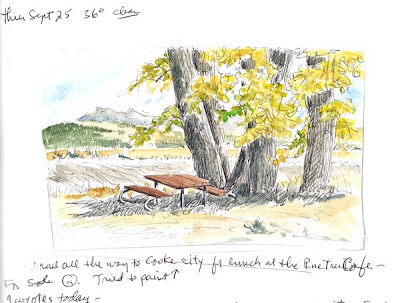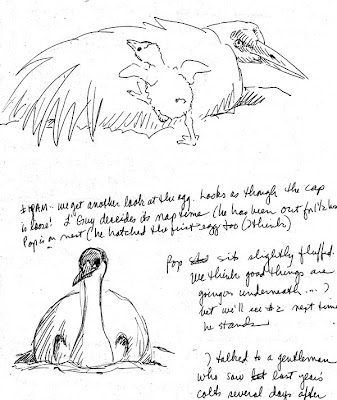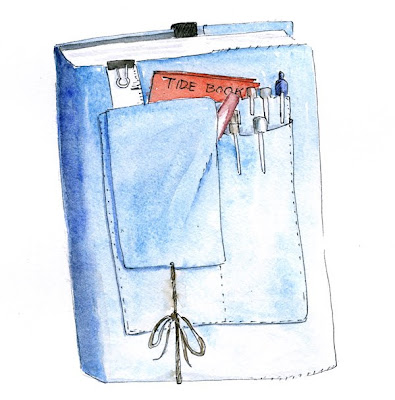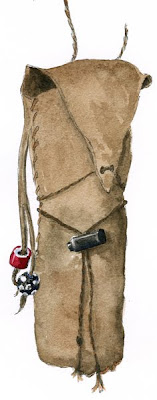I’ve been intending to write a blog post on journaling and sketching on location – the raw material for my blog posts. The day has come, partially inspired by a wonderful new blog, “Artists Journal Workshop” hosted by Cathy Johnson, a long time journaler. She has a book coming out on the journals of several artists and is sharing in-dept interviews on her blog. For more on that go to: http://artistsjournalworkshop.blogspot.com.Many, many years ago I started a carefully crafted journal in a beautiful leather binding and with pages I could take out and rearranged to my heart’s content. It was intended to be carefully thought out and reflect the highlights of our life. I always seemed to be a year behind. Finally I just gave up.

Almost ten years later, in 1976 I started another. This time my plans weren’t nearly as grand. I just wanted a notebook in which I kept ideas for paintings, what flowers bloom in May, when do the sage grouse strut, what birds did we see, lots of sketches and even some painted ideas. I happened to start out in a 8 ½ x 11 hard bound blank book. Little did I know that keeping a journal would become a way of life. I’m now in the middle of volume 37. My journals get hard use. I frequently thumb through them to look for information, or just to enjoy where life has taken us.
Soon I realized I wanted to capture more than just simple notes: watching beaver storing their winter food supply at Schwabacher Pond in Grand Teton National Park; or the five minutes of orange light when the rising sun first hits the Douglas Firs on the western edge of Klamath Lake -- Moments in time I want to remember forever.
It didn’t take long before I realized I had developed a format which works for me:
1. Keep it personal, but not private. I enjoy letting others peek into my journal
2. I want all the art in my journal to be my original work. Prior to digital cameras and the computer the art was all done on location. Now it is a mix of on-location work and at home work. I can download the camera onto the computer and start a drawing a few minutes after coming home – while the excitement of what I just saw still has my juices rumbling. I may draw some published (magazine) photographs for practice, but never in my journal.
3. Preferably entries should be done right now, not the next morning or even that night. Better to write while the action is in front of me rather than trusting my memory to catch enough important details. Sometimes it is too dark to see my page, but I still scribble away, just dropping my finger down to pick a lower spot for the next line of writing. Too often I busy photographing a ‘happening’ but I start writing as soon as possible, or jot down phrases between shots or paint brush strokes.
4. It is a ‘working journal,’ not an end product. I feel free to scratch out words, whole sentences. I stop drawing if the bird has flown and I don’t remember what its tail looks like. I dare to try a difficult pose even if the odds of it turning out well are slim. It is such a joy when a field sketch works.

5. I am hard on my journal. I put it in the car, usually on my lap, nearly every time we get in the car. I learned early on a hardbound journal lasts longer if I put a cloth cover over it right away.
One day it dawned on me how handy it would be to have my drawing equipment right there with me too …. So I added pockets to my journal cover. I sew a good sturdy cover out of denim or light canvas and add the pockets. That cover goes from one journal to the next until it is too frayed to continue on. Meanwhile each finished journal gets a simple cover made out of a different piece of fabric. Bozeman, Montana has two wonderful fabric stores where I find most of my cover material.
 Key items in or on my journal:
Key items in or on my journal:
1. Six inch ruler (clipped on so it doesn’t slip out)
2. Assortment of pens, pencils, and ‘click’ eraser
3. Waterbrush ( a paint brush with an internal reservoir of water)
4. Elastic band to hold page open when it is windy ( black band on back cover)
5. “Reserve Pocket’ (Tied down pocket -- I’m always losing a pen so I try to keep an extra set of pens and pensils here).
About a year ago I added a fountain pen to my everyday work materials …. But fountain pens pose problems. We often drive from one elevation to another. Unless the fountain pen is stored with its nib upright, the pen will bleed ink. To solve this I made a little leather pouch to hold it. The pouch stays either hanging on my neck or hanging from a knob on the dash of the car. No more bleeding ink.
My paint is the simplest part. I have an ancient metal box of Pelikan pan watercolors that once belonged to my mother. When a pan is used up, I can just squish more tube paint into the pan and give it a day or two to dry. I even added a four more pans for more favorite colors.
Brushes I keep in a rather flat plastic box. I drilled holes in the lid so the brushes will dry, and I pack some tissue next to the handles so they can’t rattle about and end on their noses. The box even has room for more pencils – water soluble graphite is one of my favorites.
When I hike I want to travel light. I’m usually carrying a camera so I put my art supplies in a fanny pack. It is just big enough to hold a 6 x 9 spiral bound sketchbook with better paper, my brush box and paint box, a little jar of water, hat and gloves.























